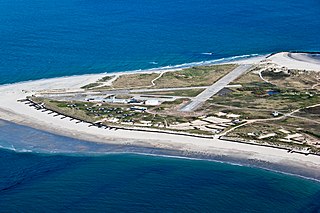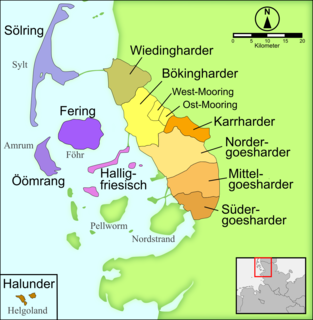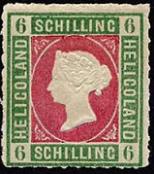 W
WHeligoland is a small archipelago in the North Sea. A part of the German state of Schleswig-Holstein since 1890, the islands were historically possessions of Denmark, then became the possessions of the United Kingdom from 1807 to 1890, and briefly managed as a war prize from 1945 to 1952.
 W
WThe first Battle of Heligoland took place on 4 June 1849 during the First Schleswig War and pitted the fledgling Reichsflotte against the Royal Danish Navy, which had blocked German naval trade in North Sea and Baltic Sea since early 1848. The outcome was inconclusive, with no casualties, and the blockade went on. It remained the only battle of the German fleet.
 W
WThe Battle of Heligoland was fought on 9 May 1864, during the Second Schleswig War, between a Danish squadron led by Commodore Edouard Suenson and a joint Austro-Prussian squadron commanded by the Austrian Commodore Wilhelm von Tegetthoff. The action came about as a result of the Danish blockade of German ports in the North Sea; the Austrians had sent two steam frigates, SMS Schwarzenberg and Radetzky, to reinforce the small Prussian Navy to help break the blockade. After arriving in the North Sea, Tegetthoff joined a Prussian aviso and a pair of gunboats. To oppose him, Suenson had available the steam frigates Niels Juel and Jylland and the corvette Hejmdal.
 W
WThe Battle of Heligoland Bight was the first naval battle of the First World War, fought on 28 August 1914, between ships of the United Kingdom and Germany. The battle took place in the south-eastern North Sea, when the British attacked German patrols off the north-west German coast. The German High Seas Fleet was in harbour on the north German coast while the British Grand Fleet was out in the northern North Sea. Both sides engaged in long-distance sorties with cruisers and battlecruisers, with close reconnaissance of the area of sea near the German coast—the Heligoland Bight—by destroyer.
 W
WThe Second Battle of Heligoland Bight, also the Action in the Helgoland Bight and the Zweiten Seeschlacht bei Helgoland, was an inconclusive naval engagement fought between British and German squadrons on 17 November 1917 during the First World War.
 W
WThe Battle of the Heligoland Bight was the first "named" air battle of the Second World War, which began the longest air campaign of the war, the Defence of the Reich. On 3 September 1939, the United Kingdom declared war on Nazi Germany after the German invasion of Poland, which started the European War. The British did not assist Poland by land or sea but RAF Bomber Command flew several missions against German targets. A number of these air raids were directed at Kriegsmarine warships in German ports to prevent their use in the Battle of the Atlantic. With the front lines static between September 1939 and May 1940, a period known as the "Phoney War" set in, with little fighting on land or in the air.
 W
WDüne is one of two islands in the German Bight that form the Archipelago of Heligoland, the other being Heligoland proper.
 W
WHeinrich Gätke was a German ornithologist and artist.
 W
WThe Helgoland Island air disaster occurred on 9 September 1913 after the airship Zeppelin LZ 14 had been transferred to the Imperial German Navy on 7 October 1912. As the first airship owned by the Navy, it was given the serial number L-1. Ordered to participate in manoeuvers, it departed the mainland in bad weather. With 20 people on board, L-1 flew into a gale, and, while 18 miles from its destination, the cold rain caused its gas to contract, causing it to settle 32 km; 17 nmi (20 mi) north of Heligoland into the North Sea, breaking in two. The control car sank, drowning 13 of its occupants. Seven were rescued by motor torpedo boats.
 W
WHeligoland Airport is an airfield on the German island of Düne, the smaller of the two isles of the Heligoland archipelago in the North Sea, about 70 kilometres (43 mi) from the mainland.
 W
WThe Heligoland Bight, also known as Helgoland Bight, is a bay which forms the southern part of the German Bight, itself a bay of the North Sea, located at the mouth of the Elbe river. The Heligoland Bight extends from the mouth of the Elbe to the islands of Heligoland and lies between the East Frisian island of Wangerooge and the North Frisian peninsula of Eiderstedt.
 W
WThe Heligoland Bird Observatory, one of the world's first ornithological observatories, is operated by the Ornithologische Arbeitsgemeinschaft Helgoland e.V., a non-profit organization which was founded in 1991 to support research on the fauna of Heligoland, a small German archipelago, comprising the islands of Heligoland and Düne, in the Heligoland Bight of the North Sea. The principal research focus is on bird migration through banding studies. Over 400 species have been recorded. OAG Helgoland produces an annual bird report.
 W
WHeligolandic (Halunder) is the dialect of the North Frisian language spoken on the German island of Heligoland in the North Sea. It is spoken today by some 500 of the island's 1,650 inhabitants and is also taught in schools. Heligolandic is closely related to the insular North Frisian dialects of Fering and Öömrang because medieval fishery around Heligoland attracted Frisians from Föhr and Amrum, and close contacts have been maintained ever since. In fact Fering and Öömrang are closer in linguistic aspects to the dialect of Heligoland than to that of their neighbouring island Sylt, Söl'ring. Heligolandic also contains a variety of loanwords from 19th-century Modern English due to the 83-year British control of the island.
 W
WHeligoland Lighthouse is located on Germany's only offshore island, Heligoland. Constructed during World War II as an anti-aircraft tower, it was turned into a lighthouse in 1952. It features the strongest light on the German North Sea coast with a range of 28 nautical miles (52 km) so that it can be seen as far as on the East Frisian or the North Frisian islands and Halligen. The lighthouse is operated by the Tönning water and shipping authority.
 W
WA Heligoland trap is a large, building-sized, funnel-shaped, rigid structure of wire mesh or netting used to trap birds, so that they can be banded or otherwise studied by ornithologists.
 W
WThe Heligoland–Zanzibar Treaty was an agreement signed on 1 July 1890 between the German Empire and Great Britain.
 W
WLange Anna, is a 47-metre (154 ft) high sea stack of Buntsandstein in the North Sea island of Heligoland, Germany. Its local name is Nathurn Stak. Climbing the stack is not allowed but tourists may view the rock from a distance.
 W
WDuring the period when Heligoland was a British possession, about 20 postage stamps were issued between 1867 and 1890. There were up to eight printings of a single denomination and also a large volume of reprints which are known as the Berlin, Leipzig and Hamburg Reprints, respectively. The Berlin reprints are sometimes better quality than the originals. The reprints were done between 1875 and 1895. Consequently, many "old" collections contain reprints rather than originals. Some believe there were seven million reprints as compared to the known 1½ million originals, of which perhaps half were sold through the post office and the remainder sold to dealers when withdrawn from use. A few printings were never postally sold but nevertheless found their way into the hands of dealers. The stamps were printed by the Prussian State Printing Office in Berlin. They were denominated in the Hamburg Schilling until 1875, when both German Reich and British values appeared on each stamp issue. All are embossed with a silhouette of Queen Victoria excepting the four highest values which represent Heligoland escutcheons.
 W
WProject Hummerschere was a construction project proposed by Nazi Germany's Kriegsmarine to expand the naval facilities on the island of Heligoland in the years leading up to World War II. Intended to create a large naval installation for operations in the North Sea, the plan involved expanding the island to its pre-1629 dimensions, restoring large areas which had been eroded by the sea. Construction was planned to more than double the usable area of both islands of Heligoland, allowing for the creation of a major naval base and Luftwaffe installation.